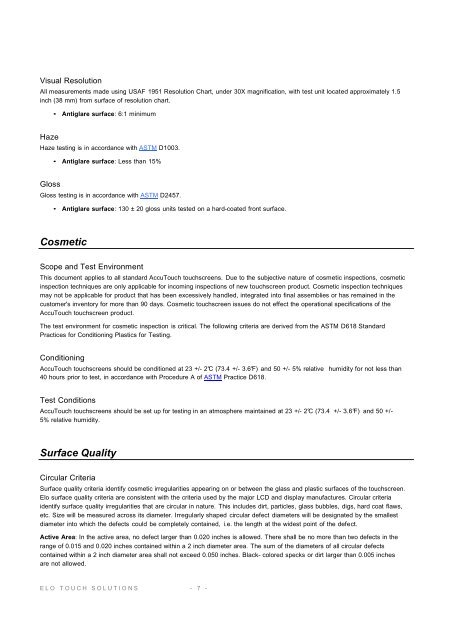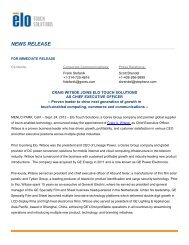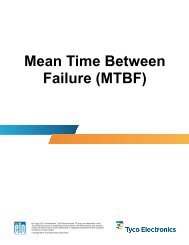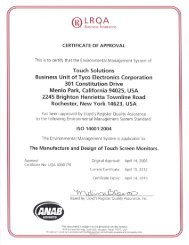Trueflat Accutouch Technology Specifications
Trueflat Accutouch Technology Specifications
Trueflat Accutouch Technology Specifications
You also want an ePaper? Increase the reach of your titles
YUMPU automatically turns print PDFs into web optimized ePapers that Google loves.
Visual Resolution<br />
All measurements made using USAF 1951 Resolution Chart, under 30X magnification, with test unit located approximately 1.5<br />
inch (38 mm) from surface of resolution chart.<br />
Haze<br />
• Antiglare surface: 6:1 minimum<br />
Haze testing is in accordance with ASTM D1003.<br />
Gloss<br />
• Antiglare surface: Less than 15%<br />
Gloss testing is in accordance with ASTM D2457.<br />
• Antiglare surface: 130 ± 20 gloss units tested on a hard-coated front surface.<br />
Cosmetic<br />
Scope and Test Environment<br />
This document applies to all standard AccuTouch touchscreens. Due to the subjective nature of cosmetic inspections, cosmetic<br />
inspection techniques are only applicable for incoming inspections of new touchscreen product. Cosmetic inspection techniques<br />
may not be applicable for product that has been excessively handled, integrated into final assemblies or has remained in the<br />
customer's inventory for more than 90 days. Cosmetic touchscreen issues do not effect the operational specifications of the<br />
AccuTouch touchscreen product.<br />
The test environment for cosmetic inspection is critical. The following criteria are derived from the ASTM D618 Standard<br />
Practices for Conditioning Plastics for Testing.<br />
Conditioning<br />
AccuTouch touchscreens should be conditioned at 23 +/- 2°C (73.4 +/- 3.6°F) and 50 +/- 5% relative humidity for not less than<br />
40 hours prior to test, in accordance with Procedure A of ASTM Practice D618.<br />
Test Conditions<br />
AccuTouch touchscreens should be set up for testing in an atmosphere maintained at 23 +/- 2°C (73.4 +/- 3.6°F) and 50 +/-<br />
5% relative humidity.<br />
Surface Quality<br />
Circular Criteria<br />
Surface quality criteria identify cosmetic irregularities appearing on or between the glass and plastic surfaces of the touchscreen.<br />
Elo surface quality criteria are consistent with the criteria used by the major LCD and display manufactures. Circular criteria<br />
identify surface quality irregularities that are circular in nature. This includes dirt, particles, glass bubbles, digs, hard coat flaws,<br />
etc. Size will be measured across its diameter. Irregularly shaped circular defect diameters will be designated by the smallest<br />
diameter into which the defects could be completely contained, i.e. the length at the widest point of the defect.<br />
Active Area: In the active area, no defect larger than 0.020 inches is allowed. There shall be no more than two defects in the<br />
range of 0.015 and 0.020 inches contained within a 2 inch diameter area. The sum of the diameters of all circular defects<br />
contained within a 2 inch diameter area shall not exceed 0.050 inches. Black- colored specks or dirt larger than 0.005 inches<br />
are not allowed.<br />
E L O T O U C H S O L U T I O N S - 7 -





